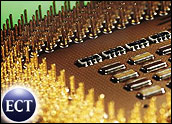
IBM and Power.org member Rapport unveiled a new energy-efficient processor dubbed Kilocore that features more than 1,000 processing elements around a Power chip architecture.
Kilocore — with parallel processing similar to that of the new Cell processor, Sun’s Niagara, and Azul’s multi-core chip — has the ability to join hundreds or even thousands of parallel processing elements on a single chip that saves energy by cutting the distance for computing signals.
Ideal for processing images and video for mobile gaming, consumer electronics or even “suitcase supercomputing,” the new Kilocore design is expected to be among the most energy efficient chips of its kind, backers said.
Parallel Power
Introduced at this week’s Embedded Systems Conference in San Jose, Calif., the Kilocore 1025 will have 1,024 processing elements with a PowerPC core on a single chip. The chip overcomes energy challenges by assembling all of the parallel processing elements together on the tiny chips themselves.
Kilocore will also be capable of streaming live, high-definition video on low-power, mobile devices at five to 10 times the speed of existing processors, Rapport and IBM claimed.
Rapport currently offers a KC256 chip featuring 256 processing elements for more than 25 gigabyte operations per second using less than a single watt of electricity. That processor is available with development platform and tools.
On-Chip Computing
The Kilocore technology is not entirely new, as other processor architectures — including the Cell chip developed by IBM, Sony and Toshiba — have featured the parallel approach, according to Gartner Vice President Martin Reynolds.
“It’s not something entirely new, but it certainly is one of the more advanced designs we’ve seen,” he told TechNewsWorld.
The processor and its architecture are able to achieve the power savings with performance thanks to more closely-connected computing resources, Reynolds explained.
“If you can keep all the computing on the chip, it cuts the power use,” he said. “Everything’s very localized.”
Different Application
Instead of running Windows, Linux, or other modern computer operating systems, the architecture and high-density cores of chips such as Kilocore are best suited to specific algorithms, including video and code compression, Reynolds said.
“It’s really focused on doing a single task very well,” he said.
Although Kilocore’s promoters touted the ability to dynamically reconfigure the chip for compute-intensive applications, Reynolds indicated such work can be difficult.
Still, the analyst called the chip an interesting approach, and one to watch as algorithms and applications evolve around it.
Architecture Ecosystem
The Kilocore technology came out of Power.org, a community of hardware and software companies formed around IBM’s Power processor architecture.
“We couldn’t have built this relationship without Power.org,” said Rapport President Frank Sinton. “Combining the outstanding Power architecture with Kilocore will open up Power’s extensive application base and developer community to the world of handheld, mobile and in-the-field computing.”
Other Power.org developments include: low-power extensions to the PowerPC 970MP processor from IBM; Teak Technologies, a startup focused on high-speed packet interconnects that chairs a Power.org subcommittee; and Thales Computers, which is building systems for extreme conditions with the low-power PowerPC 970FX.





















































